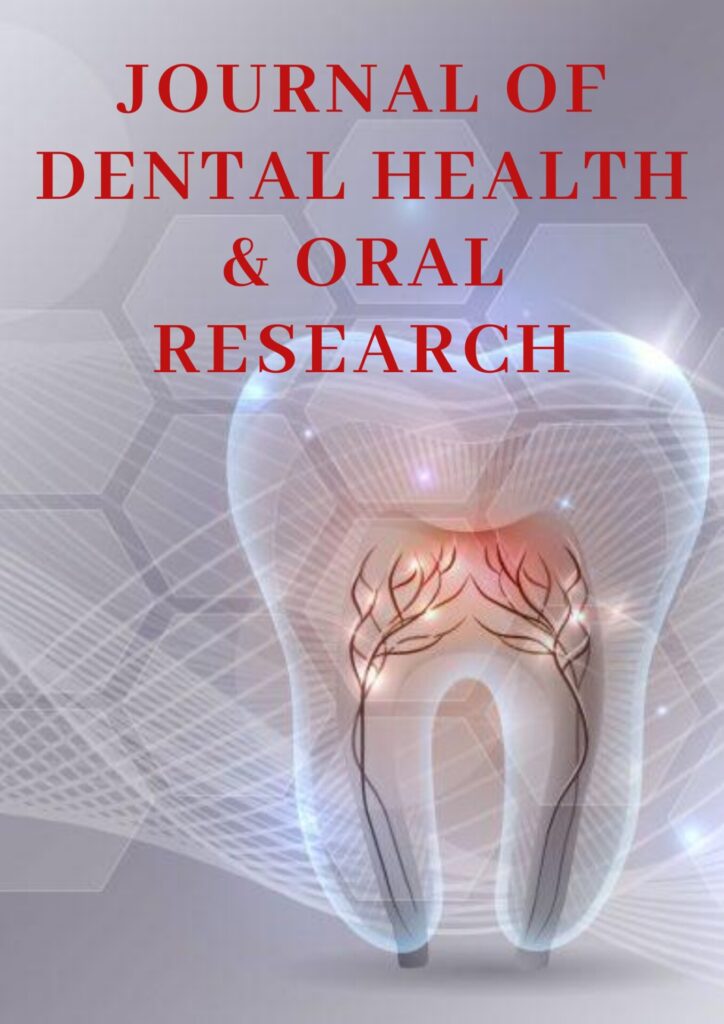Case Report | Vol. 6, Issue 1 | Journal of Dental Health and Oral Research | Open Access |
Mandibular Brown Tumor Linked to Tertiary Hyperparathyroidism: A Case Report
Shahbaz Katebzadeh1, Catherine Flaitz2, Donald Hull3, Anne Wilson4, Chaitanya Puranik5
1Assistant Professor, Pediatric Dentistry, Children’s Hospital Colorado and University of Colorado’s School of Dental Medicine, Aurora, CO, USA
2Professor and Chair, Division of Diagnostic Sciences University of Colorado School of Dental Medicine, Aurora, CO, USA
3Oral and Maxillofacial Surgery Adjunct Faculty, Children’s Hospital Colorado, Aurora, CO, USA
4Professor, Pediatric Dentistry, Children’s Hospital Colorado and University of Colorado’s School of Dental Medicine, Aurora, CO, USA
5Associate Professor, Pediatric Dentistry, Children’s Hospital Colorado and University of Colorado’s School of Dental Medicine, Aurora, CO, USA
*Correspondence author: Chaitanya P Puranik, BDS, MS., M.Dent.Sci., Ph. D., Associate Professor, Director of Residency Program in Pediatric Dentistry Children’s Hospital Colorado and School of Dental Medicine, University of Colorado Anschutz Medical Campus, 13123 East 16th Avenue, Box B240, Aurora, CO, USA;
E-mail: [email protected]
Citation: Katebzadeh S, et al. Mandibular Brown Tumor Linked to Tertiary Hyperparathyroidism: A Case Report. J Dental Health Oral Res. 2025;6(1):1-6.
Copyright© 2025 by Katebzadeh S, et al. All rights reserved. This is an open access article distributed under the terms of the Creative Commons Attribution License, which permits unrestricted use, distribution, and reproduction in any medium, provided the original author and source are credited.
| Received 18 December, 2024 | Accepted 12 January, 2025 | Published 19 January, 2025 |
Abstract
Introduction: Brown Tumors (BT) are rare, non-neoplastic, osteolytic lesions associated with Hyperparathyroidism (HPT). BTs are rare in the craniofacial region and diagnosis is uncommon in children.
Case report: A nine-year-old female presented with significant cortical expansion of the anterior, right mandible with an intact mucosal surface and mobility of permanent incisors (#23-26). The medical history included end-stage renal disease secondary to hypoplastic kidneys, severe malnutrition, rickets disease and tertiary HPT (2494 pg/mL). Blood urea nitrogen (68 mg/dL), calcium (12.3 mg/dL), and creatinine (4.1 mg/dL) values were elevated. The patient received regular hemodialysis along with vitamin D supplements and calcimimetics. The panoramic radiograph revealed a diffuse, ground-glass appearance of bone, consistent with renal osteodystrophy. Computed tomography imaging exhibited a well-circumscribed, osteolytic lesion with cortical thinning of the right mandible in the parasymphyseal region (11×13×12 mm). Histopathologic examination demonstrated a giant cell lesion, consistent with BT.
Conclusion: Management of BT ranges from conservative intralesional steroid injection to recontouring or excision. In this case, ongoing management aims to stabilize renal insufficiency and hyperparathyroidism, which is essential for achieving partial or complete resolution of the BT.
Keywords: Brown Tumor; Hyperparathyroidism; End-Stage Renal Disease
Introduction
Brown Tumors (BTs) are localized, non-neoplastic, osteolytic lesions associated with Hyperparathyroidism (HPT) secondary to renal insufficiency or failure [1,2]. In patients with renal insufficiency, Parathyroid Hormone (PTH) levels become elevated in response to hypocalcemia, hyperphosphatemia, and vitamin D deficiency [3]. BTs are described in a small number (1.5-1.7%) of cases with chronic renal insufficiency or failure [2]. In contrast, early diagnosis of HPT is more common due to extensive laboratory screening as a part of medical management of chronic renal insufficiency or failure [4,5]. Hence, a clinical finding of a BT in patients with renal insufficiency or failure is rare. BT can occur in any bone in the body and are typically seen as a solitary or multiple lesions in the long bones, pelvis, ribs, clavicle and femur [6-8,10]. Less than 5% of BTs are seen in the craniofacial region [4,9]. There is a slight female predilection and a mean age of 45 years [10]. BTs are most commonly diagnosed in the mandible as compared to maxilla in adults and rarely more than 3 cm [9,10]. Diagnosis of BTs in children is rare with only six reported pediatric cases in young children during the primary or mixed dentition stages [3,4,6,9,10].
Clinically, BTs in the craniofacial region may present as a symptomatic or asymptomatic jaw swelling [5]. The lesions can grow in size and can cause bone deformities or pathological fractures [5]. Radiographically, BTs typically present as a radiolucent lesion with a ‘ground glass’ appearance, non-corticated borders, and expansile changes in the bony contours [11]. Dental findings include root resorption and loss of lamina dura with associated teeth [12,13]. The histopathological features of BT are similar to giant cell granulomas with multinucleated giant cells resembling osteoclasts, pools of hemorrhage and hemosiderin deposition in a fibrovascular stroma [3,4,6]. The histopathologic differential diagnosis for BTs includes giant cell granulomas, giant cell tumors of bone, aneurysmal bone cysts, and cherubism [7,10]. Diagnosis of a BT is based on a constellation of clinical, radiographic, histopathologic, and laboratory findings [9,10]. Management of BT requires a multidisciplinary approach by a team of endocrinologists, nephrologists, radiologists, pathologists, dentists, and general surgeons. Treatment of the underlying HPT often involves partial or complete parathyroidectomy with or without surgical resection of the bony lesion [10].
This case report presents a medically complex child featuring a BT with a concurrent diagnosis of tertiary HPT. This case provides clinical, radiographic, histopathologic, and evidence-based findings to prepare clinicians for the detection and interdisciplinary management of such unique cases.
Case Description
A nine-year-old female reported to the Dental Center at Children’s Hospital Colorado with a chief complaint of asymmetric, right-sided mandibular swelling in the anterior vestibule and mobility of lower anterior teeth for three months. All patient information and clinical findings reported are masked or anonymized in compliance with institutional ethical guidelines and the Health Information Portability and Accountability Act.
Social history: The patient was a recent immigrant to the United States and established medical-dental care at the Children’s Hospital Colorado in Aurora, Colorado.
Medical history: The patient had a positive history of hypoplastic kidneys with end-stage renal disease (stage 5), chronic anemia secondary to renal failure, and a glomerular filtration rate less than 15 ml/minute. She had nutritional deficiencies, a feeding Gastrostomy tube (G-tube), metabolic bone disease (rickets disease), cardiomyopathy, and mitral valve insufficiency, in addition to hypertension secondary to renal compromise. In addition to hemodialysis every third day, she received daily vitamin D supplements, cyproheptadine (2 mg), cinacalcet (12.5 mg), isradipine (0.8 mg), and sevelamer carbonate (2400 mg) daily. She was allergic to non-steroidal anti-inflammatory drugs and up-to-date with immunizations. The patient’s height and weight were under 5th percentile for age and body mass index was at the 38th percentile. The patient’s significant serum parameters and values with normal ranges are presented in Table 1.
Blood Parameters | Values | Normal Range |
Blood Urea Nitrogen | 68 mg/dL | 7-17 mg/dL |
Creatine | 4.10 mg/dL | 0.23-0.61 mg/dL |
Total Calcium | 12.3 mg/dL | 8.8-10.1 mg/dL |
Parathyroid | 2494 pg/mL | 8.7-77.1 pg/mL |
Ferritin | 370 ng/mL | 10-60 ng/mL |
Vitamin D | 33.29 ng/mL | 30-96 ng/mL |
Phosphorus | 6.15 mg/dL | 4.3-6.2 mg/dL |
Alkaline phosphatase | 2,243 U/L | 156-386 U/L |
Table 1: Serum parameters relevant for end-stage renal disease, hyperparathyroidism, and brown tumor.
Clinical Findings
Intraoral examination revealed a large, firm, expansile, oval lesion (5 cm diameter) localized to the right parasymphyseal region of the mandible on the facial aspect (Fig. 1). The overlying mucosa was thin and pale with superficial vascularity but no ulceration. The swelling was tender and firm on palpation with obliteration of the labial vestibule. There was no occlusal interference due to the swelling and the permanent mandibular incisors adjacent to the lesion demonstrated class II mobility with mild lingual displacement (Fig. 1). There was generalized enamel hypoplasia with and dental caries involving all primary and permanent molars. There was no lymphadenopathy in the craniofacial region.
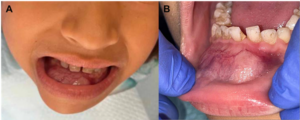
Figure 1: Extraoral (A) and intraoral (B) clinical photograph of the lesion.
Radiographic Findings
An occlusal radiograph of the site demonstrated a large radiolucency with indistinct borders, hazy internal pattern with loss of lamina dura associated with mandibular incisors (#23-26), root displacement and mild loss of alveolar crestal bone. The surrounding bone showed a ground-glass trabecular pattern (Fig. 2). Bitewing radiographs exhibited enamel hypoplasia of permanent first molars and a distal carious lesion on #B (Fig. 2). The panoramic radiograph revealed a diffuse, ‘ground-glass’ appearance of the trabecular bone with generalized loss of the cortical bone, lamina dura, dental crypt, and outline of the inferior alveolar canal. A full-complement of developing dentition was noted; however, there was significant distal displacement of tooth #27, mild distalization of #20 and #29 and delayed eruption of both #22 and #27 (Fig. 2). A computed tomography scan, two months prior to the dental exam, revealed a well-circumscribed lytic lesion of the right parasymphyseal mandibular body measuring 11x13x12 mm. The coronal, axial, and sagittal (Fig. 3) views of the scan revealed the lesion was anterior to the right central and lateral mandibular incisors and appeared to contact the incisor roots with marked thinning of the anterior mandibular cortex. Although not shown, skeletal radiographs demonstrated extensive renal osteodystrophy with multiple bilateral Salter II fractures of the long bones.
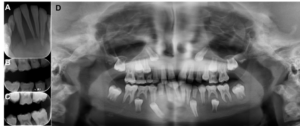
Figure 2: Intraoral periapical radiograph of mandibular anterior region (A), right (B) and left (C) bitewing radiographs, and panoramic radiograph (D).
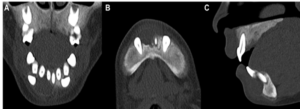
Figure 3: Coronal (A), axial (B), and sagittal (C) computed tomographic images two months prior to dental examination.
Histopathologic Findings
Incisional biopsy was performed under general anesthesia. The biopsy was submitted for histopathological evaluation. The hematoxylin and eosin-stained section showed a giant cell lesion characterized by bland spindle cells in a collagenous background with abundant non-uniformly distributed multinucleated giant cells and scattered vasculature. Spicules of lamellar bone with inconspicuous osteoblastic rimming were also noted (Fig. 4). The cellular fibrovascular stroma had extravasated erythrocytes with hemosiderin deposition. Evidence of cortical perforation and spicules of reactive bone were observed along with rare mitotic figures (Fig. 4).

Figure 4: Hematoxylin and eosin-stained section (10X magnification) showing Multinucleated Giant Cell (MGC), scattered Blood Vessels (BV), spicules of Lamellar Bone (LB) with inconspicuous Osteoblastic Rimming (OR) (A, scale bar 100µm). Hematoxylin and eosin-stained section (40X magnification) showing numerous and variably sized Multinucleated Giant Cells (MGC) (B, scale bar 50µm).
Discussion
BTs are non-neoplastic lesions with diagnosis in children a rare occurrence. The lesions most commonly develop in response to systemic disorders associated with HPT that is defined as primary, secondary, or tertiary. BTs are more common with primary and secondary HPT and only 3.6% of reported BTs are found in tertiary hyperparathyroidism [9]. This emphasizes the rare nature of this clinical case. The diagnosis of HPT is specific for each type. Primary HPT is the most common type with the majority of cases resulting from a single parathyroid adenoma [13]. Primary HPT exhibits hypercalcemia and hypophosphatemia. Secondary HPT results from chronic renal disease and inadequate calcium absorption or vitamin D deficiency [7,13]. In contrast to primary HPT, secondary HPT is associated with hypocalcemia and hyperphosphatemia [14]. Tertiary HPT is the rarest type and seen in patients with chronic secondary HPT with autonomous hypersecretion of PTH [14,15]. Tertiary HPT is uniquely characterized by hypercalcemia and elevated alkaline phosphatase [7]. Management of tertiary HPT is more complex (Fig. 5).
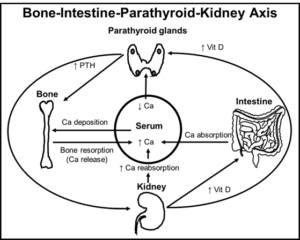
Figure 5: Bone-Intestine-Parathyroid-Kidney (BIPK) axis for calcium homeostasis [15].
The bone-intestine-parathyroid-kidney axis is a tightly controlled system in the human body associated with calcium homeostasis (Fig. 5) [15]. In response to hypocalcemia, PTH is secreted by the parathyroid gland to mediate release of calcium and phosphorus through bone resorption and renal reabsorption of calcium and phosphorus wasting [15]. PTH also mediates increased renal production of vitamin D, which promotes increased calcium absorption through the gastrointestinal tract [15]. Osteoclast production stimulated by PTH results in bony hemorrhage and intralesional deposition of hemosiderin pigments resulting in a reddish-brown coloration. Hence, the lesion designation as a BT [2]. In children, craniofacial BTs are highly rare [3,4,6,9,10]. Precise diagnosis is crucial for effective management and achieving early stabilization of PTH levels [7]. Mandibular BTs are often radiographically and histologically similar to central and peripheral giant cell granulomas, giant cell tumors, aneurysmal bone cysts, and early-stage cherubism [10]. Comprehensive laboratory testing is essential to confirm the diagnosis of BT and guide management decisions. The primary focus for management of BT is to address the specific endocrine abnormality resulting in increased PTH levels [3]. Medical management with hemodialysis, calcimimetics, and phosphate binders can mitigate HPT and in advanced cases, kidney transplant may be warranted [9,13]. Medical management alone can reduce the BT size [3]. Systemic or intralesional corticosteroids can further reduce the lesion size [3,16]. Medical management often leads to partial or complete tumor regression in 10-25 months [18]. Complete resection of the BT or osteoplasty of the involved bone may be recommended in severe cases [30,16,17]. More than half of reported cases of BT have been treated with medical management with or without parathyroidectomy [18]. Surgical treatment often is recommended for severe cases that are refractory to medical management [10]. Surgical treatment with medical management has been associated with complete resolution of the BT without recurrence [13].
Conclusion
Early diagnosis of HPT is more common due to extensive laboratory screening as a part of medical management of chronic renal insufficiency or failure. Hence, a clinical finding of BT is rare. However, as the family was in process of immigrating to the United States, the diagnosis and care for the patient was delayed leading to the manifestation of an expansile jaw lesion, consistent with BT with long-standing renal disease. The highlight of this case report is the detailed account of clinical, radiographic, histopathologic and laboratory findings of a BT in a young child with a multidisciplinary approach to care. While tertiary HPT is rare, a BT diagnosis in a tertiary HPT case is unusually rare in the pediatric population. This underscores the value of this case report. A limitation of the case is the inability to report on long-term follow-up and the impact of medical management without surgical resection on the patient’s quality of life. Due to the limited number of pediatric craniofacial BT cases published in the literature, an evidence-based protocol for management of pediatric BT cases has not been established. Hence, reporting of high-quality pediatric BT cases of the jaws is warranted to inform multidisciplinary care of this unusual complication. Dental clinicians should schedule regular follow-up for BT patients with long-lasting renal disease to ensure timely interventions.
Conflict of Interest
There are no potential conflicts of interest to declare in this paper.
Author Contributions
All authors contributed equally for this paper.
References
- Friedman WH, Pervez N, Schwartz AE. Brown tumor of the maxilla in secondary hyperparathyroidism. Arch Otolaryngol Chic Ill 1960. 1974;100(2):157-9.
- Brown TW, Genant HK, Hattner RS, Orloff S, Potter DE. Multiple brown tumors in a patient with chronic renal failure and secondary hyperparathyroidism. AJR Am J Roentgenol. 1977;128(1):131-4.
- Pinto MC, Gambeta Sass SM, Pupo Sampaio CP, Campos DS. Brown tumor in a patient with hyperparathyroidism secondary to chronic renal failure. Braz J Otorhinolaryngol Engl Ed. 2010;76(3):404.
- Kabila B, Beqqali B, Obilat S, Haddad SE, Allali N, Chat L. Mandibular brown tumor revealing hyperparathyroidism in a patient with neurofibromatosis type 1: case report. Glob Pediatr Health. 2023;10:2333794X231219168.
- Shetty AD, Namitha J, James L. Brown tumor of mandible in association with primary hyperparathyroidism: a case report. J Int Oral Health JIOH. 2015;7(2):50-2.
- Unlü RE, Abaci E, Kerem M, Aksoy E, Sensöz O. Brown tumor in children with normocalcemic hyperparathyroidism: a report of two cases. J Craniofac Surg. 2003;14(1):69-73.
- Dos Santos B, Koth VS, Figueiredo MA, Salum FG, Cherubini K. Brown tumor of the jaws as a manifestation of tertiary hyperparathyroidism: A literature review and case report. Spec Care Dentist. 2018;38(3):163-71.
- Sia HK, Hsieh MC, Yang LH, Tu ST. Maxillary brown tumor as initial presentation of parathyroid adenoma: a case report. Kaohsiung J Med Sci. 2012;28(7):400-3.
- Pham M, Bhatt P, Purvey TA. Massive exophytic brown’s tumor of the bilateral maxilla with mandibular involvement. J Craniofac Surg. 2022;33(3):897-900.
- Glassman GE, Williams JK, Brady CM. A mandibular brown tumor: a pediatric case report and summary of adolescence cases. FACE. 2024;5(3):543-9.
- Guéroult AM, Cameron M. Rare brown tumour of the mandible secondary to tertiary hyperparathyroidism in a renal transplant recipient. BMJ Case Rep CP. 2019;12(9):e231231.
- Polat P, Kantarci M, Alper F, Koruyucu M, Suma S, Onbaş O. The spectrum of radiographic findings in primary hyperparathyroidism. Clin Imaging. 2002;26(3):197-205.
- Triantafillidou K, Zouloumis L, Karakinaris G, Kalimeras E, Iordanidis F. Brown tumors of the jaws associated with primary or secondary hyperparathyroidism. A clinical study and review of the literature. Am J Otolaryngol. 2006;27(4):281-6.
- Selvi F, Cakarer S, Tanakol R, Guler SD, Keskin C. Brown tumour of the maxilla and mandible: a rare complication of tertiary hyperparathyroidism. Dento Maxillo Facial Radiol. 2009;38(1):53-8.
- Younes NA, Shafagoj Y, Khatib F, Ababneh M. Laboratory screening for hyperparathyroidism. Clin Chim Acta Int J Clin Chem. 2005;353(1-2):1-12.
- Martínez-Gavidia EM, Bagán JV, Milián-Masanet MA, Lloria de Miguel E, Pérez-Vallés A. Highly aggressive brown tumour of the maxilla as first manifestation of primary hyperparathyroidism. Int J Oral Maxillofac Surg. 2000;29(6):447-9.
- Reséndiz-Colosia JA, Rodríguez-Cuevas SA, Flores-Díaz R. Evolution of maxillofacial brown tumors after parathyroidectomy in primary hyperparathyroidism. Head Neck. 2008;30(11):1497-1504.
- Qaisi M, Loeb M, Montague L, Caloss R. Mandibular brown tumor of secondary hyperparathyroidism requiring extensive resection: a forgotten entity in the developed world? Case Rep Med. 2015;2015(1):567543.
Author Info
Shahbaz Katebzadeh1, Catherine Flaitz2, Donald Hull3, Anne Wilson4, Chaitanya Puranik5
1Assistant Professor, Pediatric Dentistry, Children’s Hospital Colorado and University of Colorado’s School of Dental Medicine, Aurora, CO, USA
2Professor and Chair, Division of Diagnostic Sciences University of Colorado School of Dental Medicine, Aurora, CO, USA
3Oral and Maxillofacial Surgery Adjunct Faculty, Children’s Hospital Colorado, Aurora, CO, USA
4Professor, Pediatric Dentistry, Children’s Hospital Colorado and University of Colorado’s School of Dental Medicine, Aurora, CO, USA
5Associate Professor, Pediatric Dentistry, Children’s Hospital Colorado and University of Colorado’s School of Dental Medicine, Aurora, CO, USA
*Correspondence author: Chaitanya P Puranik, BDS, MS., M.Dent.Sci., Ph. D., Associate Professor, Director of Residency Program in Pediatric Dentistry Children’s Hospital Colorado and School of Dental Medicine, University of Colorado Anschutz Medical Campus, 13123 East 16th Avenue, Box B240, Aurora, CO, USA;
E-mail: [email protected]
Copyright
Shahbaz Katebzadeh1, Catherine Flaitz2, Donald Hull3, Anne Wilson4, Chaitanya Puranik5
1Assistant Professor, Pediatric Dentistry, Children’s Hospital Colorado and University of Colorado’s School of Dental Medicine, Aurora, CO, USA
2Professor and Chair, Division of Diagnostic Sciences University of Colorado School of Dental Medicine, Aurora, CO, USA
3Oral and Maxillofacial Surgery Adjunct Faculty, Children’s Hospital Colorado, Aurora, CO, USA
4Professor, Pediatric Dentistry, Children’s Hospital Colorado and University of Colorado’s School of Dental Medicine, Aurora, CO, USA
5Associate Professor, Pediatric Dentistry, Children’s Hospital Colorado and University of Colorado’s School of Dental Medicine, Aurora, CO, USA
*Correspondence author: Chaitanya P Puranik, BDS, MS., M.Dent.Sci., Ph. D., Associate Professor, Director of Residency Program in Pediatric Dentistry Children’s Hospital Colorado and School of Dental Medicine, University of Colorado Anschutz Medical Campus, 13123 East 16th Avenue, Box B240, Aurora, CO, USA;
E-mail: [email protected]
Copyright© 2025 by Katebzadeh S, et al. All rights reserved. This is an open access article distributed under the terms of the Creative Commons Attribution License, which permits unrestricted use, distribution, and reproduction in any medium, provided the original author and source are credited.
Citation
Citation: Katebzadeh S, et al. Mandibular Brown Tumor Linked to Tertiary Hyperparathyroidism: A Case Report. J Dental Health Oral Res. 2025;6(1):1-6.

